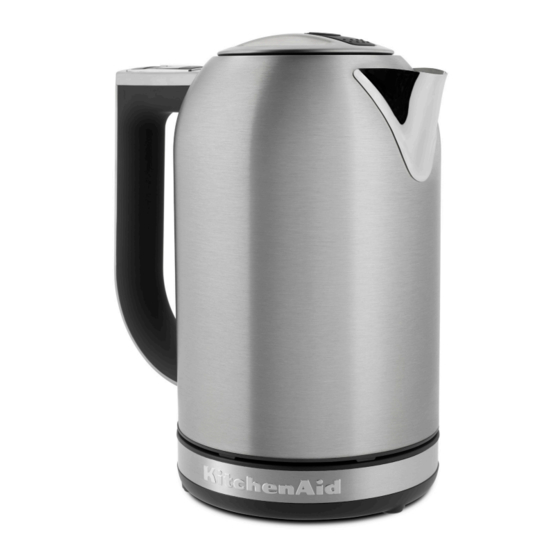
Table of Contents
Advertisement
Quick Links
Advertisement
Table of Contents

Summary of Contents for KitchenAid 5KEK1835A
- Page 1 5KEK1835A W10597348C_EN.indd 1 12/18/2018 4:36:26 PM...
-
Page 2: Parts And Features
PARTS AND FEATURES PARTS AND ACCESSORIES Water fill Lid release button location Control panel Water filter 1.7 L (7 cup) Electric Kettle Water gauge window Base with power cord Underside of base with power cord wrap 2 | PARTS AND FEATURES W10597348C_EN.indd 2 12/18/2018 4:36:27 PM... -
Page 3: Electric Kettle Safety
ELECTRIC KETTLE SAFETY IMPORTANT SAFEGUARDS When using electrical appliances, basic safety precautions should always be followed, including the following: 1. Read all instructions. Misuse of appliance may result in personal injury. 2. Do not touch hot surfaces. Use handles or knobs. 3. - Page 4 ELECTRIC KETTLE SAFETY 7. If the supply cord is damaged, it must be replaced by the manufacturer, its service agent or similarly qualified persons in order to avoid a hazard. 8. Unplug Electric Kettle from outlet when not in use and before cleaning.
- Page 5 Do not operate the kettle unless the element is fully immersed. Do not move while the kettle is switched on. 27. Visit www.KitchenAid.com.au or www.KitchenAid.co.nz website to download this instruction manual. SAVE THESE INSTRUCTIONS ELECTRIC KETTLE SAFETY | 5 W10597348C_EN.indd 5...
-
Page 6: Electrical Requirements
ELECTRIC KETTLE SAFETY ELECTRICAL REQUIREMENTS Volts: 220-240 V Hertz: 50-60 Hz Wattage: 2400 W NOTE: If the plug does not fit in the outlet, contact a qualified electrician. Do not modify the plug in any way. Do not use an extension cord. If the power supply cord is too short, have a qualified electrician or service technician install an Electrical Shock Hazard... -
Page 7: Operating The Electric Kettle
OPERATING THE ELECTRIC KETTLE BEFORE FIRST USE BEFORE FIRST USE Before first use, fill the Electric Kettle to the maximum level, then boil and discard the water. The temperature can be displayed in Celsius (C) or Fahrenheit (F). To change setting, hold the “-”... -
Page 8: Heating Water
OPERATING THE ELECTRIC KETTLE HEATING WATER °C °F Place the Electric Kettle on the base. The Electric Kettle has eleven programmed The display will show the default temperature settings. temperature (100° C). Press the “+” or “-” buttons to select your desired water temperature. -
Page 9: Temperature Guide
OPERATING THE ELECTRIC KETTLE TEMPERATURE GUIDE Use this guide for outstanding results from your KitchenAid Electric Kettle. 60° C 70° C 80° C 90° C 100° C Delicate Tea Green Tea Blooming Tea Black Tea Boil Water Gyokuro Earl Grey... -
Page 10: Turning Off The Electric Kettle
OPERATING THE ELECTRIC KETTLE TURNING OFF THE ELECTRIC KETTLE The Electric Kettle can be turned off in several ways: Press Start/Cancel while in heating Press Start/Cancel while in Keep Warm mode. Unplug cord when Electric Kettle mode. Unplug cord when Electric Kettle is not is use. -
Page 11: Cleaning The Filter
CARE AND CLEANING CLEANING THE FILTER The Electric Kettle features a removable mesh filter that traps scale deposits for cleaner water. The filter will need to be cleaned periodically—more often if you have hard water. To access filter: Open the lid; the filter Clean under hot water with a soft brush is located behind spout inside Electric or cloth to remove deposits, and replace... -
Page 12: Customer Service
SERVICE CUSTOMER SERVICE In Australia: For any questions, or to find the nearest Authorised KitchenAid Service Centre, please find our contact details below. NOTE: All service should be handled locally by an Authorised KitchenAid Service Centre. - Page 13 W10597348C_EN.indd 13 12/18/2018 4:36:35 PM...
- Page 14 W10597348C_EN.indd 14 12/18/2018 4:36:35 PM...
- Page 15 W10597348C_EN.indd 15 12/18/2018 4:36:35 PM...
- Page 16 ©2018 All rights reserved. Specifications subject to change without notice. W10597348C 12/18 W10597348C_EN.indd 16 12/18/2018 4:36:36 PM...
















Need help?
Do you have a question about the 5KEK1835A and is the answer not in the manual?
Questions and answers